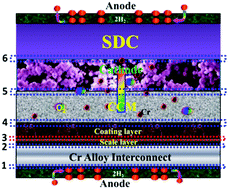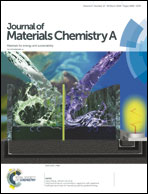Systematic effect of contaminations on IT-SOFCs cathode stability: a quantifiable correlation versus cathode-side poisoning and protection†
Abstract
The study of cathode-side poisoning in solid-oxide fuel cells due to Cr, H2O, and CO2, etc., has attracted wide interest from the viewpoint of marketability. However, overall perspectives of poisoning/protection of the entire cathode side and multivariate analyses of the cathode side are rare and deserve more attention. The multiple factors, such as contamination, the cathode contact material (CCM) layer, the protective layer, poisoning, and the cathode lifetime that govern the overall performance of the cathode side should be considered comprehensively/integrally rather than solely (as single parameters). In this work, with experimental results as proof, a systematic study of the quantifiable correlation between cathode-side poisoning/protection and contaminations has been performed, and the novelty and significant contributions are listed here: (1) with objective and consistent external factors, a systematic comparison of the most popular CCM layer and protective layer was carried out and a quantifiable correlation versus cathode-side poisoning and protection was demonstrated; (2) a systematic comparative study of the cathode-side multifunctional system by quantification of cathode-side poisoning with ferritic steels as interconnects at different contaminant contents; (3) a clarification of the distribution of various contaminants in the cathode-side 3D configuration and a demonstration of valid solutions for slowing down and even preventing poisoning by chromium, H2O and CO2; (4) a summary of the individual or multidimensional synergistic mechanism of the multi-tiered CCM/coating structure that acts as an accessory device at the cathode side; (5) optimization of the CCM appraisement system, making a reassessment of existing CCM candidates and proving their additional benefit, for instance, as a Cr vapor getter. Finally, the area specific resistance (ASR) of cell specimens with a multipurpose protective/connective structure was measured for 4000 h at different levels of contaminants to determine the long-term stability of the cathode. The degradation rates of Rp and Rohm values of the cathode drastically decreased from 484.3 and 99.2 to 11.2 and 4.3 μΩ cm−2 h−1 (from 484.3 and 99.2 (1000 h) to 44.8 and 17.3 mΩ cm−2 (4000 h)), which represented decline by factors of 43 and 23, respectively.



 Please wait while we load your content...
Please wait while we load your content...